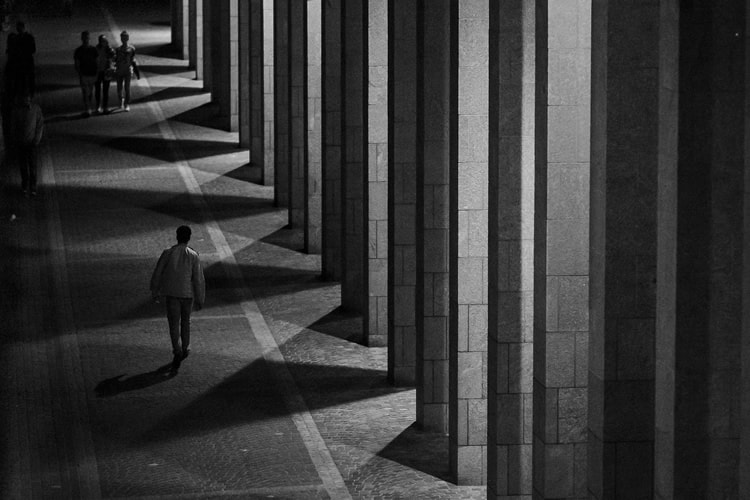As photographers, we know to look for the light! It is one of the most important aspects of a photo, and can often turn a lackluster image into a spectacular one. The times of day when the lighting is at its best – during beautiful sunsets, for example, and after a storm, or during the golden hour can result in some truly striking images.
But while lighting is tremendously important, the absence of light, is important too. We’re talking about shadows, and yes – these blocks of darkness can create some unique and intriguing photos. In fact, far from simply being an absence of light, shadows help to shape the light, and draw attention to it.
They can also add a sense of visual interest to a photo, directing attention, and can add contrast and depth to an image.

image by jwltr freiburg [1]
Mysterious and intriguing, these dark spaces can add a lot more to an image than you may have ever thought possible. Here’s how you can use shadows to enhance your photos.
Compositional Tips
While shadows are often unwanted in images – during a portrait, or on a subject’s face, for example – don’t rule out shadows completely! In the right context, a shadow can drastically enhance a composition [2], adding a vivid sense of interest and drama. Here are a few ways that shadows can liven up a composition.
-
Direct Focus
Shadows are an excellent way to direct the viewer’s focus to the main focal point. Since shadows appear as strong, contrasting points of interest, they can be used as an effective compositional tool for grabbing, and directing attention. When composing your images, notice the shadows. Watch how they catch your attention, and think of how you can incorporate them into the image to draw focus to a specific aspect of the photo.
-
Reveal Form
Shadows are often used to reveal form. The long shadows that are created during the afternoon light can present some excellent photo opportunities – especially for landscape photography. The position of the horizon in relation to the sun results in long shadows that stretch across the landscape, calling attention to the form and texture of the earth – and presenting the perfect chance to capture some dramatic images.
-
Draw Out Texture
While it’s often difficult to see texture in full sun or brightly lit settings, shadows are a great way to emphasize and draw attention to texture. This is true for both landscape photography, and close-ups. To draw out the texture, look for side lighting or wait for times when the sun is at a lower angle rather than directly overhead. Instead of drowning the image in full light, side lighting will help to reveal subtle textures, adding an extra sense of dimension to a photo.
-
Create Patterns
Try looking for patterns in shadows. Think of the way the light filters through a grated stairwell, or the dappled sunlight as it filters through the trees. Or, get creative and make your own patterns. Compositions that contain both shadows and patterns can make for some dramatic and compelling photo opportunities.

image by Ines Njers [3]
Photo Opportunities
Shadow photography provides the perfect opportunity to develop your photographic eye. Photographing shadows encourages you to be creative and break from routine, and gets you in the mode to look for interesting and unique photo opportunities. Here are some photographic opportunities that you can look for.
-
Compose Black and White Images
Paying close attention to shadows is the best way to capture black and white imagery. Black and white photography is especially concerned with shapes, tones, and texture – making shadows and highlights especially important with this type of photography. Black and white photography is a great challenge to see the world in terms of shadows, tones, and details – all valuable compositional elements that can help to enhance your photos.
-
Create Abstract Photos
Abstract photography, similar to abstract art – relies on form, texture, color, and shape more than it does detail. Shadows are a great chance for abstract photography since there are endless possibilities for patterns, shapes, and tones.
-
Capture Unique Portraits
Whether you choose to play up the shadows subtly by using them to enhance your subject, or compose your images so that they’re the main focal point, shadows present a great opportunity for capturing unique and dramatic portraits.
-
Make Shadows the Subject
One fun way to use shadows, is to make them the main focal point of an image. This works especially well when you have a strong subject, like a person or animal, that’s casting a strong shadow against a simplified background. You can also turn your photo upside down so that the shadow faces the right direction and becomes the main subject – resulting in a fun and attention-grabbing photo.

image by Kevin Dooley [4]
Quality of Light
Not all shadows are created equal! The light will have a big impact on the resulting shadow, and will determine how harsh or soft it is. Direct lighting will result in strong and well-defined shadows, while softly diffused light will create softer shadows. The best shadows for your image depend upon the type of composition that you’re going for, and the mood that you’re trying to create.
While it’s easy to focus on paying attention to the light, don’t forget the shadows in the process. By learning to read both the light, and the shadows, you’ll be able to take advantage of both of these powerful compositional elements to capture some truly spectacular results.
Have you incorporated shadows into you photography? We’d love to see your results! Please share your tips or photos with us via Twitter [5] or Facebook [6].